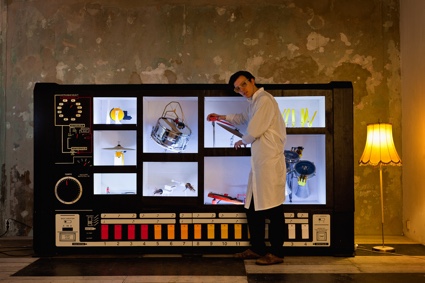 MR-808 Drum Robot. Photo: Jürgen Lösel
MR-808 Drum Robot. Photo: Jürgen Lösel
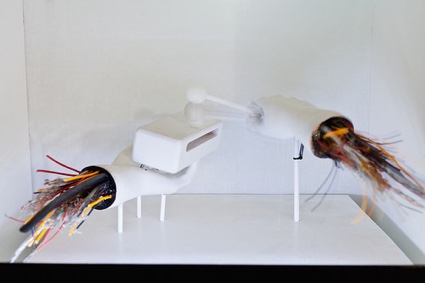 MR-808 Drum Robot. Photo: Jürgen Lösel
MR-808 Drum Robot. Photo: Jürgen Lösel
Moritz Simon Geist is a classical musician and a robotics engineer who builds his own musical instruments and seems to genuinely and tirelessly have fun in the process. The most famous of his creations is the MR-808, an oversized replica of the TR-808 produced by Roland to reproduce drum sounds. This 1980s electronic drum machine imitated the drum so inadequately that it actually created its own sound. The distinctive ‘thump thump’ became an integral part of hip hop music, gained iconic status with Marvin Gaye’s Sexual Healing and reached such a cult position within the music industry that even Kayne West paid tribute to the machine in his hit album 808s and Heartbreak.
Geist’s TR-808 opens up MR-808’s guts and allows us to see how the sounds are mechanically produced. The installation recreates 11 sounds of the TR-808 using mechanical actuators and physical tone generators and displays them inside an oversized wooden replica of the original instrument.
The artist went further with the installation MR-808 Interactive that invites the audience to collectively program the instrument using a touchpad.
His most intriguing creation however is probably the Glitch Robot which uses small robots to move, beat, hit and produce acoustic sounds, emphasizing thus the origin of the sound in a way no conventional medium of electronic music production is able to.
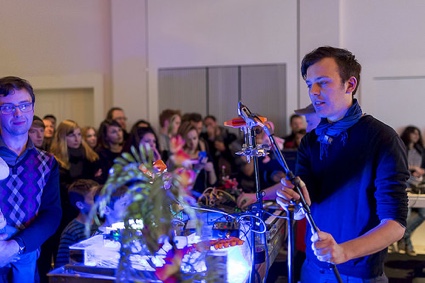 SONIC ROBOTS at Cynetart, 2014. Photo by David Pinzer
SONIC ROBOTS at Cynetart, 2014. Photo by David Pinzer
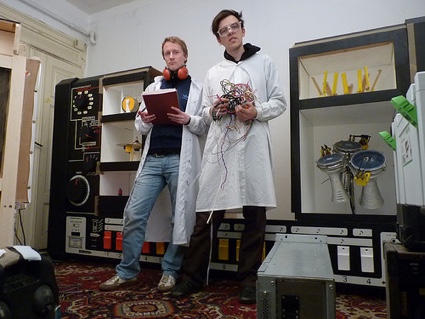 MR-808 Drum Robot. Photo: Jürgen Lösel
MR-808 Drum Robot. Photo: Jürgen Lösel
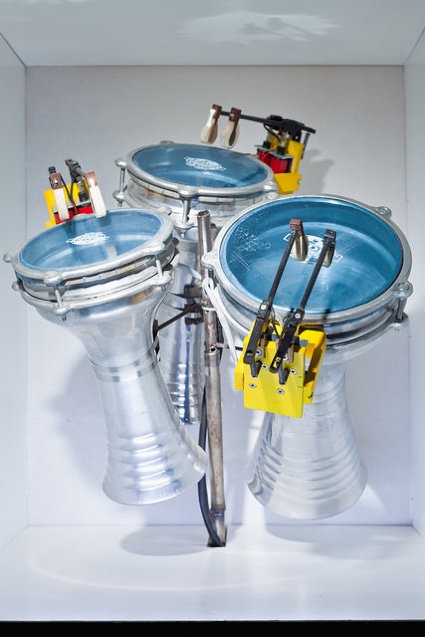 MR-808 Drum Robot. Photo: Jürgen Lösel
MR-808 Drum Robot. Photo: Jürgen Lösel
Moritz Simon Geist, MR 808. Filmography: David Campesino
Moritz Simon Geist and his Sonic Robots will be performing at the Rokolective festival in Bucharest on 11th and 12th of September. The weekend of performances is part of SHAPE, a European platform for innovative music and audiovisual art. I thought i’d take the event as an excuse to get in touch with the artist and discover more about his robots, ambitions and passions:
Hi Moritz! First, i’ve got to ask about the Roland TR-808. What attracted you to the instrument and made you want to develop a work based on it? Did you have one before making robots, for example?
Unfortunately, I never owned an 808, although it was invented in the year of my birth! I started dealing with electronics and robotics when I was quiet young. I started playing guitar at 14 and building my own guitar effects. From there I somehow got to robotics – now you would call it sound art – hacking the vinyl and tape recorder of my parents (the were not amused!). Years later I continued with robotic sound experiments. And then one day – I suppose it was in a bar or under the shower – I had the idea to give all these experiments a “frame” and to take the most famous drum machine of all time was kind of obvious after that. Actually during the building process I was obsessed for some time that somebody might come up with that project before me. Well .. it didn’t so happen, maybe the idea wasn’t that SO obvious.
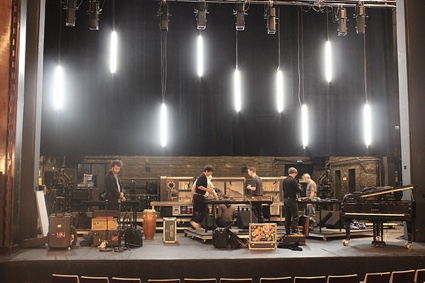 MOM + TYONDAI + SONIC ROBOTS at HAUBerlin
MOM + TYONDAI + SONIC ROBOTS at HAUBerlin
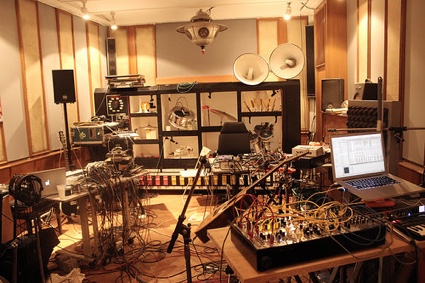 MOM + TYONDAI + SONIC ROBOTS at HAUBerlin
MOM + TYONDAI + SONIC ROBOTS at HAUBerlin
You are a musician and the musical instruments you create are visually very striking. They are both elegant and playful. What guides the aesthetically choices you make while developing a new machine? And how important is the visual aspect of the robot?
I never studied Design or Arts, so in the beginning I wasn’t used to all these fancy design processes, mood boards and the like, and I did most of it just by “well-that feels good / that doesn’t”.
Still the visual aspect is probably 50% of music robots. If an art piece doesn’t convince visually, it loses a lot of its power. People can get an “image” so much easier, where you would need five sentences in text to describe the idea, and attention is the most hard-fought currency.
One might have the best concept and the best idea but in the end it needs an image to get that direct contact to the audience’ attention. So design is definitely super important.
When I start building a new machine I try to get an overall picture of what I want. In general in robotics big movements are good. You can see something good when it’s moving a lot. But on the other hand this is the most difficult to do – big motors, heavy equipment, long latencies. So you ask yourself: How shall it look like on stage? How can I videotape it? What time shall it refer too (70s, retro futurism, steam punk ..)? Then you can get example pictures and you get an overall idea of how things shall be and you start to design.
Still, in the end, time always runs out and you are hunted by pragmatism, leaving all your design aspects aside. Music Robotics is such a big field – mechanics, electronics, programming, music – so all theses things come before the design when the piece has to be released in two weeks.
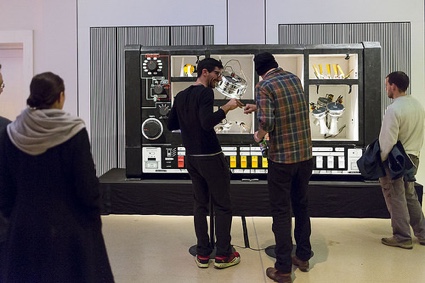 SONIC ROBOTS at Cynetart, 2014. Photo by David Pinzer
SONIC ROBOTS at Cynetart, 2014. Photo by David Pinzer
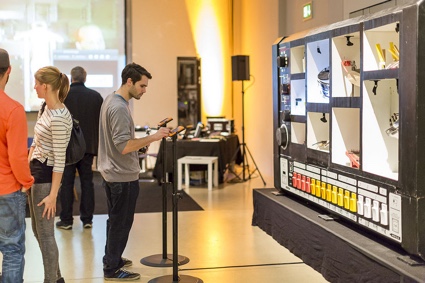 SONIC ROBOTS at Cynetart, 2014. Photo by David Pinzer
SONIC ROBOTS at Cynetart, 2014. Photo by David Pinzer
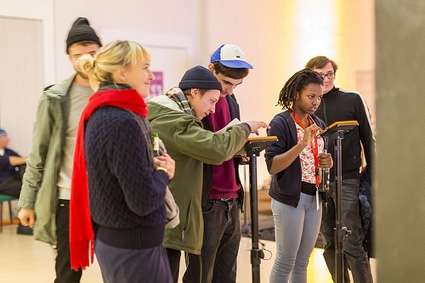 SONIC ROBOTS at Cynetart, 2014. Photo by David Pinzer
SONIC ROBOTS at Cynetart, 2014. Photo by David Pinzer
I’m very intrigued by MR-808 interactive where the MR-808 is programmed live by the audience. Could you tell us how it works? How can people collaboratively control a robot drum machine without the whole experience turning in to a cacophony?
The idea is that you can make a rhythm (with a step sequencer). But you don’t do it alone, it’s an open system where everybody can collaborate. Like GoogleDocs for music. Let’s jam together – on a big drum robot! Actually you could drive any drum computer with this system it doesn’t have to be the MR-808.
Technically speaking its a Node.js server which renders a website that interacts with a SuperCollider Sequencer which spits out midi. We are big fans of open source, you can find the code here https://github.com/Sonicrobots/MR-808
In theory you can interact with as many people as you like. But at our exhibitions only 2 people can play with the robot. For a good reason: Once, I was working with an art group and they developed a simple sketch board where you can write and paint stuff with a projector and it gets displayed in public. We let the people paint for hours, but after less than one hour somebody always would write something obscene of offensive. We called that “Mean Time To Dick”. Roughly 30 minutes. So this always happens. Call it cacophony or Media arts vandalism. If you are standing beside the installation for 2-3h you will see that it moves like a wave: at one hour people create something beautiful, then a small group comes in and it gets totally annoying. Than beautiful again.
So in MR-808 interactive, the robot does the music, the audience controls it. What’s your role in there?
Do you just sit back and enjoy the show?
Actually – yes! There is not much to do but explaining and fixing if something is broken. And that’s actually the idea with robots isn’t it? They shall do the work, not me!
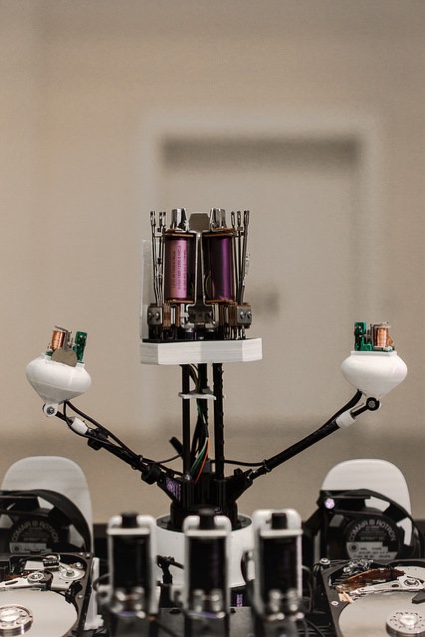 Moritz Simon Geist and the Glitch Robot. Photo: David Campesino
Moritz Simon Geist and the Glitch Robot. Photo: David Campesino
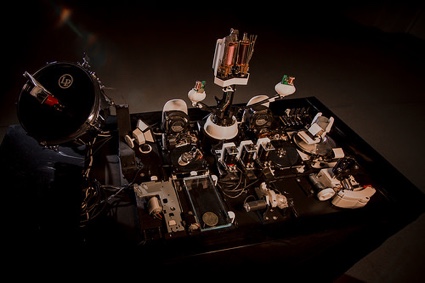 Moritz Simon Geist and the Glitch Robot. Photo: David Campesino
Moritz Simon Geist and the Glitch Robot. Photo: David Campesino
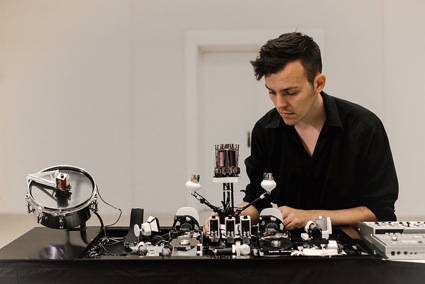 Moritz Simon Geist and the Glitch Robot. Photo: David Campesino
Moritz Simon Geist and the Glitch Robot. Photo: David Campesino
Moritz Simon Geist and the Glitch Robot (Live performance at the B-Seite Mannheim festival 2015.) Video: Roman Heller
I was reading in your bio that you are giving talks about the progression of robotics and society. So what’s your take on the role that robots will play in our society? nowadays they seem to be used mostly in entertainment or industrial contexts.
Actually, the progression in the field of artificial intelligence and machine learning (the “brain” of robotics) is quite fast these days. Google bought several robotic and robot intelligence companies including DeepMind and BostonDynamics, which resulted in fascinating to frightening results. The singularity (when machines reach the consciousness of humans) might be decades away, but a lot of steps have already been taken. You can take random science fiction literature to conceive how the world would look then. Maybe its a dystopia – or humanity will finally listen, when big machines tells them to stop the suicidal party we are currently holding on our planet.
I don’t associate robots with fallibility. I thought they were supposed to perform simple tasks impeccably. Yet, you say that with your robots you are interested in introducing more “error” into the music. Could you comment on that? Why are errors so fascinating to you?
And could you give us some example of these errors that the robots made that surprised, inspired or delighted you? (if that’s possible to explain in words!)
That’s many questions! One big topic is that industrial robots cannot be compared with the “experimental” DIY robots that I am building. Industrial robots are good and well tested and rarely fail. Experimental robots are – experimental! They do stuff you don’t plan them to do. They are not tested. They are hacked together from trash and kitchen equipment.
It appears when you play with them. The robotic stick doesn’t always hit in the right moment – like a drunken drummer. The piezo microfon moves and suddenly you have a crazy humming on the record. You have sudden and unexpected sound crosstalk. If you play two instruments at a same time a third one will trigger because the electronics is acting weird. A midi note hangs and the whole system is skipping or looping for one second. It’s not predictable.
And this is one of the things that I like: Digital art (digital music) is predictable and well calculated. Music robots aren’t. The concept behind this is, that if you have a predefined and strict set of creative tools and functions it always gets you to the same result.
You know five chords on the guitar? Super, you can play 80% of rock songs. But what happens if your guitar distunes? If you by error get the wrong note? And the skipping robot might sound really cool while skipping. It might sound shit – or it might give you the creative impulse to need to get off of the beaten track. Error is a creative nucleus for artistic work. The rest is still work.
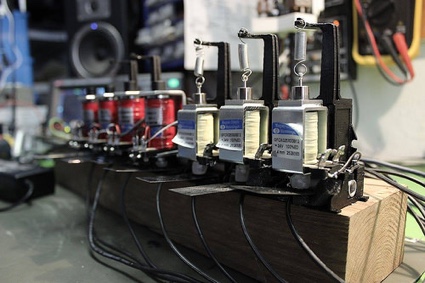
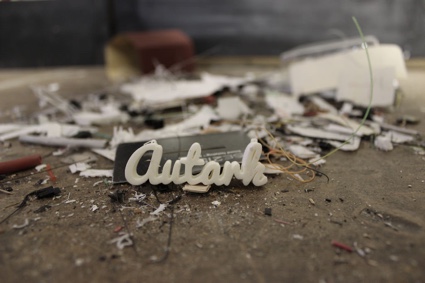 Which artists or figures from the music, robotics or art worlds do you find inspiring?
Which artists or figures from the music, robotics or art worlds do you find inspiring?
I really adore the work of Julian Oliver. His artistic and theoretic concepts make so much sense together and I am a big fan of the Critical Engineering manifesto. For some time I was also a big fan of Bre Pettis (Founder of makerbot) but he really disappointed everybody, including me. Apart from that – of course – my friends Andi and Jan from Mouse On Mars who taught me a lot about bass, error and how to deal with sound and the mystery of sound in general. Wizard geniuses, both of them!
You are going to participate to Rokolectiv festival in Bucharest this September. What will you be performing/showing there?
I will perform with the MR-808 Robot and some hacked music gear like a game boy and some modded and self build sound sculptures. We have the interactive MR-808 installations but initially it was meant to be an instrument on stage.
Thanks Moritz!
Don’t miss Moritz Simon Geist from Sonic Robots at the Rokolective festival which will take place inside the Halele Carol former power station in Bucharest on 11th and 12th of September. The event is part of SHAPE, a dynamic European platform for innovative music and audiovisual art.
Along with Geist’s presentation and performance, the festival will also feature sound performances and DJ sets by Raze de Soare, Lorenzo Senni, Sergiu Doroftei, Low Jack, DJ Nigga Fox, RSS Boys, Borusiade and Cote.
More photos of Sonic Robots in action on flickr.
